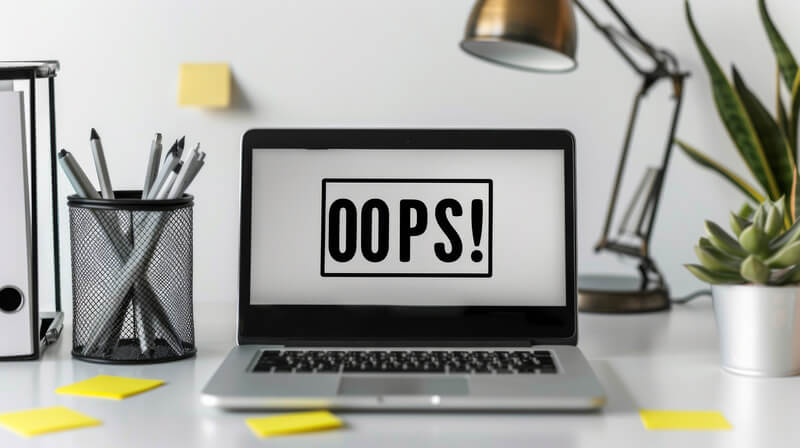As of 2025, WordPress powers 43.7% of all websites worldwide (Search Logistics). WordPress has grown significantly over the years: it’s user-friendly, flexible and incredibly versatile. But that doesn’t mean it’s without pitfalls. In 2019, we published an article on 17 most common WordPress mistakes. Things change, but some mistakes seem to be more persistent than others. Summarizing the most recent user stories and experiences shared on various public WordPress support forums, in addition to the insights gained from our own support team, in this article we’ll dive into the modern-day 23 most common WordPress mistakes and offer practical solutions on how to fix them.
Whether you’re a beginner or a pro developer, there are certain mistakes that can trip up even the most experienced WordPress users. By the end of this article, you’ll have the knowledge to adapt to the best website building practices.
#1 Choosing the Wrong Hosting Provider
Everything starts with a good PC, whether it’s the one on your desk, or the remote one you’re hosting your website on.
Choosing a hosting provider with poor infrastructure can lead slow load times, lousy performance and downtimes. You will especially feel the consequences as your site continues to grow.
Solution: invest time to find out which hosting provider would be the perfect pick for you, based on your website needs and budget. WordPress Hosting group on Facebook or Reddit’s r/webhosting can help you make a decision by checking out the experience, testimonials and advice of others.
#2 Choosing the Wrong Theme
Along with finding the most suitable hosting provider, picking the right WordPress theme is still one of the biggest challenges. Choosing the wrong WordPress theme can lead to more issues on the long run due to incompatibility, abandonment, poor coding practices, etc.
Solution: when choosing the best WordPress theme for your website, these are the key qualities you need to pay attention to:
- Maintenance: ensure the theme is still maintained and not abandoned.
- Accessibility-readiness: ensure the theme is always adapting to code-wise accessibility practices, because there are some things you won’t be able to change.
- SEO-friendliness: ensure the theme will enable you to apply best SEO practices across the entire website.
- Responsiveness (mobile-friendliness): ensure the theme is adaptable to all devices.
- Page builder support: ensure the theme supports major page builders, as that will help you greatly with your website development.
- Documentation: ensure the theme features are well documented, as this will help you get solutions and resolutions fast.
- Support: ensure developers behind the theme offer support, so you don’t have to rely on readiness of others to help you with a potential problem.
- Reviews: most online reviews and comparisons are biased (affiliation, partnerships, sponsorships), and rarely paint the real picture. Likewise, most online article reviews misrepresent features because they have never used the product, or offer seriously outdated information. Checking official communities or reviews on wordpress.org (the good, and the bad) will help you understand how things really function.
- Translation-readiness: ensure the theme is translation-ready, even if you don’t plan to make your site multilingual. Translation-ready themes ensure you’re able to translate all parts to your native language or adjust default texts per your liking.
#3 Using Pirated and Nulled Products
Pirated and nulled WordPress themes and plugins are products that have the original licensing option stripped off and replaced with a different one. These are usually sold off some shady websites that offer “original themes and plugins” for a seemingly lower price.
Likewise, these shady websites often trick their victims by charging them for themes and plugins that are 100% free to download and use via wordpress.org.
Besides these products not being the real thing, they also contain various code injections (often malicious) that open door to malware, unwanted advertising, website hijacking, viruses and other security issues that can go beyond your website.
Solution: most reputable WordPress developers sell their products through their official websites only, so make sure you’re getting the real deal. Whenever in doubt, contact the developer for more information.
#4 Using the Default “admin” Username
One of the first mistakes many users make is sticking to the default “admin” username. This is a major security risk, as it’s a common target for brute force attacks.
Other equally common usernames you should avoid include:
- administrator,
- sysadmin,
- webmaster,
- [email protected] (replace
yourwebsite.urlwith the actual URL of your website), - any username combination that includes your website’s name.
Solution: always create a unique username when setting up WordPress. Avoid using “admin” or any other obvious choices.
#5 Not Using Strong Passwords
Using weak passwords is just as dangerous as using the most common usernames for WordPress admin accounts, and represent an easy target for hackers.
Solution: use strong passwords, that combine lower and capital letters, symbols and numbers, that are at least 8 characters long. If you’re out of ideas, you can use some of the available online tools for password generation to help you out:
- Avast’s Random Password Generator,
- LastPass’ Password Generator,
- Norton’s Password Generator,
- 1Password’s Password Generator.
#6 Not Securing Your Website with the HTTPS Protocol
Websites that use the HTTP protocol (instead of HTTPS) to load and deliver data are considered as insecure. Such websites are usually marked by browsers with a broken padlock next to the URL in the address bar. In worst case scenarios, some browsers will even refuse to connect to such websites by displaying a clear warning.

An insecure website can not only cause design issues (media not loaded) or functionality issues (scripts and styles not loaded) due to the Mixed Content error, but it can also create trust issues with your visitors and have a negative impact on your SEO.
Solution: Get an SSL certificate and configure your website to enable HTTPS. SSL certificates can be obtained via:
- Hosting providers: most hosting providers offer free SSL certificates as a part of their hosting plans, which you can manage directly from your hosting account.
- Off-site solutions: some networks, for example Cloudflare, provide off-site solutions, such as CDN (Content Delivery Network), Firewalls, DDoS protection, and SSL certificates among all other services.
- Plugins: some WordPress plugins, such as Auto-Install Free SSL or Really Simple Security, enable you to add an SSL certificate directly through the WordPress admin area.
- Manually: get a free (such as Let’s Encrypt) or premium (such as Comodo) SSL certificate plan, and add it to your website per provider’s instructions.
#7 Not Having a Clear Website Structure
A messy website structure with poor navigation can confuse visitors and force them to leave quickly. Nobody wants to go through a maze and waste their time to find the price, contact form or the download option.
Some website owners provide messy websites on purpose so that they can keep visitors engaged as long as possible to boost SEO scores. This is a bad practice and does fire back badly.
Solution: create a clear, logical website structure. Organize content into categories, and ensure menus are easy to navigate.
#8 Leaving Default WordPress Settings as Is
Many users leave default WordPress settings, such as the permalink structure or site language, as they are, which can have a negative impact on SEO, or even present a security issue.
Solution: review and customize all default WordPress settings, including the permalink structure, comments settings (especially pingbacks and trackbacks), site language and timezone.
#9 Not Testing New Themes and Plugins First
Installing new and untested themes and plugins on your live website can lead to compatibility issues, as well as critical errors.

Solution: always test new themes and plugins on a staging / test / localhost website first, before implementing them on your live website. The same goes for updates of existing plugins and themes – test, then update. This approach helps prevent compatibility issues and other potential problems.
#10 Not Updating WordPress, Themes, and Plugins Regularly
Running outdated versions of WordPress, themes and plugins can leave any website vulnerable to compatibility issues, but most importantly, vulnerable to serious security issues.
While we strongly advise against automatic updates to avoid potential compatibility issues and conflicts from happening when you’re not looking, we also advise updating everything on a regular basis. In our line of work, we have witnessed websites that have not been updated in years. Updating neglected websites can be a serious challenge.
Solution: every month or two, ensure to test available updates of WordPress, themes and plugins on your staging / test / localhost website. If tests go well, update your live website after performing a backup first.
Using a security plugin ensures you’re aware if some of your themes and plugins require immediate action as soon as security patch updates become available.
You can also set phone or calendar reminders to check for updates at least once a month.
#11 Neglecting Regular Website Backups
If something goes wrong, you risk losing your most recent content (best case scenario), and potentially your entire website (worst case scenario).
Performing regular backups can prevent that. Don’t wait for your website to crash to realize the importance of regular backups.
Solution: ensure to backup your website regularly, on and off site, especially before updating or adding new themes and plugins:
- Hosting providers: many hosting providers offer automated backups, as well as backups on demand. Enable this feature if included in your hosting plan and schedule automated backups per need.
- WordPress plugins: plugins such as Updraft Plus, WPvivid, and All-in-One WP Migration can help you perform backups manually, and schedule automated backups per need. As an extra precaution measure, you can download backup files to your PC (recommended).
Expert tip: never rely on one backup solution only. Take backups via hosting and manually. Also ensure to regularly download backups.
#12 Editing the Parent Theme
Making changes to the parent theme files directly can be tempting. But, any theme update will simply overwrite all your custom changes and additions (that’s how WordPress functions).

Solution: instead of editing the parent theme files directly, ensure to use a WordPress child theme to override default parent theme functionality or add custom PHP or JS codes.
#13 Using (Too Many) Redundant Plugins
While trying to find the best solution for their websites, users often install multiple plugins that offer, more or less, same functionality. Even though they end up using one plugin, users tend to leave all those other plugins running on their websites.
In a similar manner, novices tend to install new plugins to achieve specific functionality, even though their theme or plugins they are already using offer the same.
This practice leads to slower websites, because unnecessary scripts are being loaded on the website’s frontend and backend. Likewise, it can lead to various compatibility or design issues, that can be difficult to troubleshoot.
Solution: learn everything about the theme and plugins you’re using. Remove unnecessary plugins from your website, and ensure to add plugins coming from trusted sources only. Perform regular website audits, for example every 6 months, and remove unused plugins.
#14 Ignoring Image Optimization
Large, unoptimized images can significantly increase website’s loading time. This further has negative impact on user experience and SEO.
Solution: though there are many plugins that offer image optimization on site, we recommend optimizing images before actually uploading them to your Media Gallery. Using CDN (Content Delivery Network), caching and image lazy load options can further help optimize images, as well as your entire website.
Free online image editing and optimization tools can help you get your media polished for web usage:
#15 Not Optimizing for Search Engines (SEO)
Don’t miss out on organic traffic. Properly optimize your content and try to adapt to the best SEO practices from the beginning.

Following the latest SEO trends and performing regular SEO audits can help your website rank better, and increase organic traffic.
Solution: perform keyword research and optimize your content for relevant terms. Use on-page SEO techniques, such as meta tags and meta descriptions, image ALT text, clean permalinks, and H tags hierarchy.
Using SEO plugins, such as Yoast SEO or The SEO Framework, can significantly help optimize content for SEO and social media.
#16 Overlooking Accessibility
Making your website accessible to all users, including those with disabilities, is not really a best website building practice anymore – it’s a legal requirement in some regions.
In a similar manner, by June 28th 2025, individual EU country rules will be replaced with common rules, following the European Accessibility Act (EAA).
Solution: use themes and plugins coded with accessibility in mind. Use online tools such as WAVE to perform regular audits of your website’s content. From personal experience (we use WAVE for OceanWP product development), WAVE’s browser extension provides more accuracy compared to the online scanner.
Keep in mind that tools are not perfect and you may get false positive repots. Therefore professional (human) insight and interpretation is recommended.
#17 Ignoring Website Security
WordPress’s popularity makes it a frequent target for hackers and script kiddies, but some users overlook basic security measures. This neglect often stems from a lack of awareness about the risks or the assumption that their site is too small to be targeted.
Unfortunately, this creates vulnerabilities that can be exploited, leading to data breaches, malware infections, or even complete site takeovers.
Solution: in today’s world there’s no such thing as a 100% protection, but there are always things you can do to prevent your website from getting hacked or injected with malware:
- Use HTTPS encryption protocol,
- Use strong passwords,
- Protect all website forms (login, contact, comments) with Google’s reCAPTCHA, Cloudflare’s Turnstile or CleanTalk to prevent spam and abuse,
- Scan your website for malware and suspicious activities on a regular basis,
- Use reputable security plugins, such as Wordfence, Malcare or Patchstack, to monitor and protect your website,
- Use off-site firewalls, such as Cloudflare’s WAF, to protect your site from malicious user agents, IPs, bots and DDoS attacks.
Expert tip for OceanWP Pro Bundle users: you can enforce strong password usage, limit login attempts, apply spam protection to website forms and other security measures via the Popup Login option.
#18 Using Too Many Popups or Ads
While ads can help monetize your website, and popups help generate leads, overuse of both can and will annoy website visitors, and have a negative impact on user experience.

Unless you’re giving away a house or loads of money, nobody wants to go through a ton of ads and 10 popups until they get to your content.
Solution: use ads sparingly and test their placement to ensure they don’t interfere with your site’s usability. In the exact same way, use popups sporadically and in a smart way. For example, on exit intent.
Expert tip for OceanWP Pro Bundle users: our Popup Builder enables you to create smart popups by applying them on specific pages only (or site-wide) in combination with the perfect trigger events.
#19 Neglecting Website Analytics
Without proper tracking, it’s difficult to understand how users interact with your website, understand your website’s performance or make really informed and right decisions.
Solution: set up GA Google Analytics or Independent Analytics on your site to track visitor behavior, bounce rates, conversions, and other important metrics.
#20 Confusing Maintenance and Coming Soon Modes
WordPress beginners often see no difference between the Maintenance and Coming Soon modes, except for the message – which, in their opinion, is more or less the same.
Mixing these 2 modes will not only create bad user experience, but it can also have a devastating impact on your SEO and rankings.
Solution: learn the difference between the Maintenance and Coming Soon modes, and activate each of those accordingly:
- Coming Soon: to be used when building your website the first time. This mode hides your website from SERPs, but allows indexing of your website before you launch it.
- Maintenance: to be used only while performing small updates or critical fixes, that last from a couple of minutes to a couple of days max. This mode sends a 503 notification to search engine crawlers, which is basically telling that you’re currently working on a website, that the downtime is temporary, and to come back later.
#21 Ignoring User Documentation
Many users underestimate the importance of user documentation, or assume that products are intuitive enough to navigate without guidance. This oversight can lead to confusion, errors, and inefficient troubleshooting, as users miss out on essential tips, updates, and best practices provided in the documentation.

As a result, they may encounter avoidable issues or even compromise site security and performance.
Solution: we do live in a busy world, but make time to go through user documentation – it was written for you, and it will help you get the right answers fast.
#22 Keeping the Debug Mode Active
Debug Mode is valuable for troubleshooting.
But keeping it active at all times on a live website can lead to performance issues, as well as clutter log files with excessive and often unnecessary data.
Solution: use the Debug Mode on a needs basis, ie. when your website is experiencing unexpected behavior. Ensure to disable the Debug Mode after troubleshooting.
#23 Not Testing Outgoing Emails
If you’re running a membership or eCommerce website of any kind, it’s essential to test all necessary emails are being sent out from your site.
If the email functionality is not properly tested, you risk emails being marked as spam or not being delivered at all. This can harm user experience and trust.
Solution: regularly testing outgoing emails ensures that crucial messages, such as password resets or order confirmations are sent promptly and successfully. You can use WordPress plugin such as Check & Log Email, WP Test Email or WP Email Log – Postbox to test and debug email related problems.
#24 Bonus Mistake: Confusing WordPress.org and WordPress.com
Confusing wordpress.org with wordpress.com is a very common mistake among beginners, which usually leads to missing out on many available WordPress options and features talked about all over internet.

While these 2 are related in more ways than one, they both serve different purposes.
Solution: carefully research the differences and choose the option that aligns with your needs best:
- wordpress.COM: offers managed hosting services for the WordPress platform only. Available options, such as installing plugins or using any theme you want even if it’s free, depend on the hosting plan you choose. Free plans are also available.
- wordpress.ORG: the home of WordPress – you can download the WordPress platform itself or other resources such as themes and plugins, participate and contribute to WordPress, etc. Almost all other hosting providers that offer WordPress hosting enable you to use this (unlocked, so to speak) version of WordPress, without any restrictions to the platform itself. Using the WordPress platform in this way, no matter what hosting provider you choose, is also known as self-hosted WordPress.
#25 Bonus+ Mistake: Calling Everything a Bug
Often, users assume that any issue they encounter or the lack of a specific functionality must be a technical flaw – a bug – usually within the theme. This leads to overlooking the possibility of simple user mistakes, such as incorrect settings or improper usage, first and foremost of WordPress itself.
By attributing problems solely to bugs, users may miss the opportunity to learn and correct their actions, leading to repeated errors and unnecessary support requests. This can also slow down troubleshooting processes.
And yes, this WordPress mistake is quite close to the hearts of our support team.
Solution: understanding the difference between bugs, issues, and feature requests ensures clear communication and effective troubleshooting:
- bug: a flaw or malfunction in the code that causes a specific functionality to not act as expected and thus not provide results it was designed for / designed to do, including severe results such as fatal errors that cause websites to crash.
- code issue: non-fatal issues and errors, usually related to a conflict or specific to user’s setup.
- feature request: suggestion to add new functionality and other customizations outside of product’s current features, that are meant to improve existing products.
Final Thoughts
WordPress is an incredibly powerful tool, but it’s easy to make mistakes along the way.
By avoiding the common pitfalls mentioned in this article, you’ll ensure your website is secure, runs smoothly, and provides the best experience to your users.
Take time to learn from the mistakes of others. Start implementing the best practices, and keep improving your WordPress website to achieve long-term success.
Are you or someone you know guilty of making any of these WordPress mistakes? Share your experience in the comments below.




